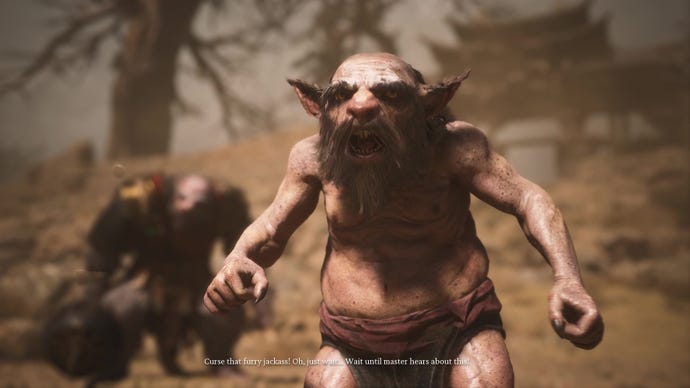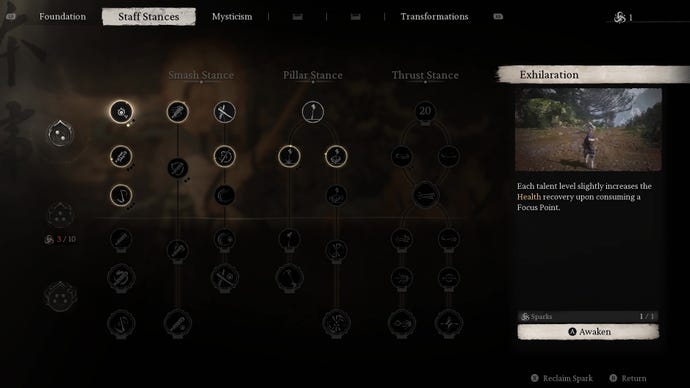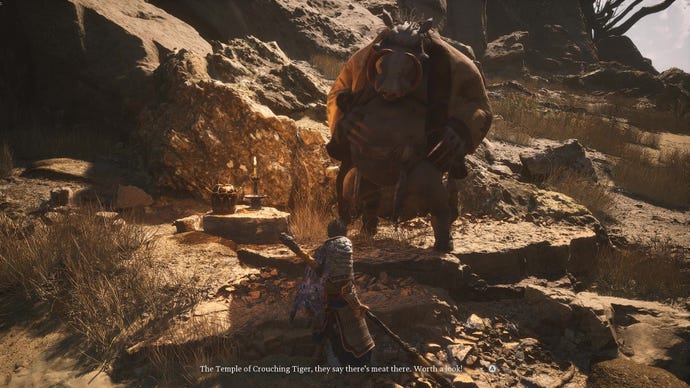
2024-08-17 07:50:02
Black Myth: Wukong is an action RPG that leans a bit into the Souls camp and a bit into the adventure camp. And either way, it’s a spectacular journey that works for mostly everyone: those after challenging fights against Chinese mythological creatures, and those after the same thing, but with a little less challenge than your typical Soulslikes. What separates Black Myth from the crowd, though, is its slick presentation and a sense of generosity. You’re to witness the most lavish, cinematic worlds and its creatures. And you’re to enjoy battering everything with your staff as a highly athletic monkey with copious spells at his furry follicles and fingertips. It’s been a while since I’ve played anything quite as impressive as this.
The game’s based on one of the great classical Chinese novels Journey To The West, which I’ve not read. But, from the start of the game I gather that Wukong rebelled against Heaven and he got kicked into the nether. Many years pass and you, a person sitting behind a screen, take control of the Destined One: a monkey who’s essentially Wukong reincarnate. What is your mission? To thwack the shite out of various Yaoguai (mythical creatures) and remind them that you’re back in the game, baby. Back to reclaim… something.

Forgive my ignorance, as I find Black Myth’s Soulsy story delivery quite difficult to follow. Those familiar with the source material or those with particularly discerning ear holes may find it a lot easier, but I struggle with rats the size of skyscrapers and headless monks speaking in riddles. Thing is, though, I don’t mind it one bit? With Souls it can frustrate, because their universes exist purely in-game and if I don’t understand something, I know the only answers lie in a 40-minute, interpretative YouTube video. With Black Myth, I’m just lapping up the spectacle, the drama, the boiling spittle ejected from the mouth of a blazing deity as it roars at me. Ignorance here only really means bliss, as no matter where you sit on the understanding scale, you’ll be adding Journey To The West to your cart immediately.
Before cosying up with the novel, though, comes the twiddling of your thumbs on a rotund piece of plastic (or the patter of your fingers, depending on whether you use the equally good mouse and keyboard). Black Myth is of the Souls school of action RPGs, for the most part: you dodge bruising enemy attacks, you wait for your stamina to recover, you drink from a Gourd to replenish health (an Estus), you rest at Shrines (Bonfires), you Get The Idea. Except it’s a generous Soulslike, to the point where it straddles – rather beautifully – the line between hard and “let’s crack on with the journey, shall we?”, making it a Souls-venture hybrid that pushes you and pushes you onwards.
Onwards through a series of slightly disjointed chapters (might make more sense in the novel), each whisking you off to realms of swaying groves and golden sands and curved roof tiles dusted with snow. Sure, some chapters have their tougher, more irritating sections, but the general rhythm of exploration is spot on. And that’s down to each realm’s linear structure, opting for more compact zones stitched together by Shrines, as opposed to, say, Elden Ring‘s vast open world.

This doesn’t mean that Black Myth’s world is one big funnel, oh no. As I said in my preview, I think its use of space is remarkably authentic, with alternate pathways that don’t feel like they’ve been laid down by a level designer’s mouse. Okay yes, there are obvious arenas and routes; this is a video game, after all. But I do think they are all designed thoughtfully, as if everything in Game Science’s power has been poured into making this a mythical universe that’s not been created just for you and your power chase.
So no, the world doesn’t interlock and intertwine quite like a Souls game. But this doesn’t mean you aren’t challenged by careful enemy placement and hidden pathways and well-paced ‘breathers’ between boss battles. There are times, though, when things are laid out in such a way that you think you’re able to jump over to a ledge or up a log and you’ll bonk an invisible wall. Eh, it’s a restriction that’s quickly shrugged off given just how beautiful Black Myth is.
Like seriously, I am unsure whether I’ve ever been wowed quite like I have with Black Myth. I can’t recall the amount of times I’ve stopped dead in my tracks and panned the camera over frescoes on rock, or idols carved into wooden panels, or the intricacy of the Chinese mythological architecture. The little details, like snow trails left by your body and your staff and the way sakura blooms out of a Shrine you’ve visited for the first time? Stop it.
Still, you are an angry monkey and there’s only so much gawping at glistening turtle incense burners you can do before it’s time to slaughter. And slaughter is channelled through your hips and your staff, where lithe movements and stick-twirls make for fights that aren’t only stylish, but punchy too. There’s no blocking, besides spinning your staff to deflect arrows, so fights are a dance of dodges and well-timed strikes at the most basic level. Defeat an enemy and they’ll drop Will (Souls), except you don’t lose these on death! Instead, Will sticks with you no matter what, and not only does it act as a currency to purchase materials and craft things (more on this in a sec), it’s a means of levelling up. Ding up and you’ll earn Sparks, which you can pop into many a skill tree.

And this is where more of Black Myth’s generosity lies. You can invest in three different staff stances: Smash, Pillar, and Thrust, each switchable on the fly and each with their own unlockable movesets. They’re all useful in certain situations, where Smash is great for one-on-one duels and general fights, Pillar lets you hop onto your staff to avoid sweeps and, later, even lets you sip from your Gourd atop it like you’ve gone for a quick old fashioned at the rooftop bar while the rabble nip at your impossibly long stool leg. Thrust is unlocked a little later, and acts almost like a spear, letting you jab from a distance, retreat, then close the gap. I love switching between them all, honestly. Alterations let you transform into even more powerful creatures for an extended time, too, like literally one of the first bosses you face.
There are yet more tools to navigate fights, which makes difficult scenarios a lot more manageable for a crowd who aren’t used to Soulslikes. The options are vast, like collectible Spirits that let you transform briefly into defeated enemies, or summon poisonous snakes from the earth. Maybe you’ll deliver a roar that knocks baddies onto their arses, or maybe you’ll slip into the body of an avian shinobi who slices with dual blades.
The Spells, though! It’s the Spells that really complement the fights, namely because they ooze style and there’s little in the way of constraint. Four slots (you’ll gradually unlock all four as you progress) are home to these abilities, each using varying slices of mana. Immobilize is one of the first spells you earn and it lets you freeze enemies in place for a short time, casting them in a golden glaze no matter where they are in their animation. It’s fantastic for catching a breather; a quick swig of the Gourd. But also for extending a combo or closing a gap. Once your foe is freed and goes for a swipe? Bam, simply turn to stone and parry it, then maybe hit ’em with the equivalent of Naruto’s shadow clone jutsu and let your doppelgangers do the work. God, it’s refreshing to be able to use these abilities so freely and seamlessly.

There’s less emphasis on equipment though. Say you’ve felled some hulking golem with your conniving spells, and they drop some crafting materials. You can combine these with Will and other materials you nab from chests, to whip up new staves and sexy armour sets. It’s a bit God Of War, in the sense that they have the rarity banners and will confer bonuses if you equip multiple pieces of the same set. There isn’t a great deal of depth here, as you’ll shift between the strongest sets as the game’s own intervals dictate. Then again, its relative simplicity doesn’t distract or overwhelm from the adventure at hand.
This means less time in menus analysing stats like you do in some other Soulslikes and more time basking in the cinema of the beasties you’ll face. All of the boss fights, whether they’re mini or not, are well-balanced, and so lavishly designed that you’ll often be floored by their presentation. The gyrating, sparkling dragons that spiral through the air. The mountains in the distance, ice crackling underfoot as you slow-mo dodge pillars of electricity. A corrupted buddha placing his palm on tiles and the earth splintering, pulsing, then erupting. And every boss backs up their spectacle with cleverly designed attack patterns and behaviours, some flaunting gimmicks like laser generators to tumble over, or reanimated monks to cleave through, all measures that keep your brain as lithe as your twiddling thumbs.

Black Myth is home to surprises, too, lots of them. A little detail I loved was one boss remarking on a spell I’d used, baffled by how I’d learned it. Then as if to spite me, he used the same technique on me two seconds later. And in a slightly less-convoluted-than-Souls style (still quite convoluted), you’ll bump into NPCs who’ll ask you for things, meaning you’ll need to revisit them as they whizz about. I can’t say much, but if you take the time to explore fully and heed their words, you’ll unlock some spectacular secret areas, with secret bosses that feel almost like you’re stumbling into some lost pages.
Black Myth: Wukong is a triumph. A surprising triumph in the sense that I can’t quite believe it’s as good as its drip feed of screens and trailers looked over the last few years. It’s a generous Soulsy adventure hybrid that works within its limitations and delivers a beautiful challenge to be unpicked with a magical toolbox. Arguably, I’d say Black Myth’s world sucked me in more than Elden Ring and Lies Of P, probably more so than anything I’ve played in ages! This is Game Science bursting onto the scene and saying: “You’ve got competition”. And hey, I’m listening. You should be, too.
This review is based on a review build of the game provided by the developer.





